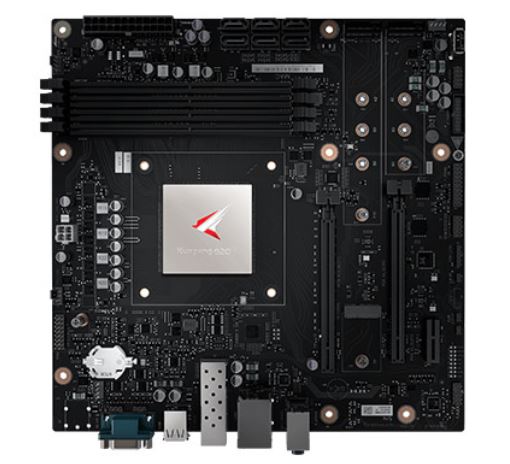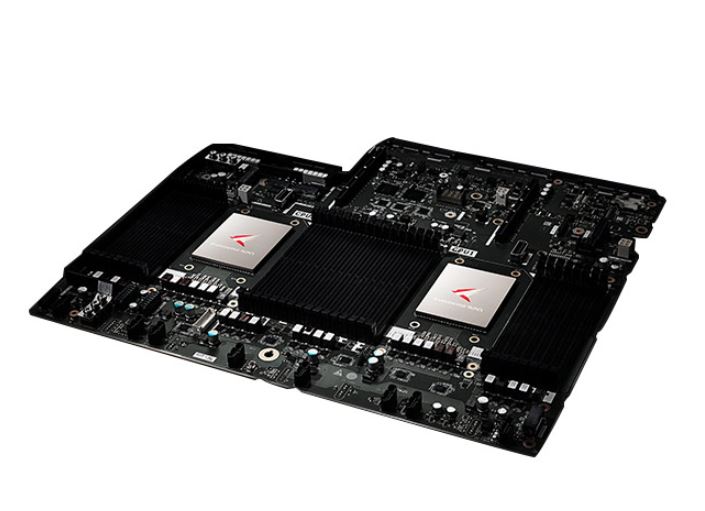Huawei Aims for Desktop PC Market with Motherboard for Kunpeng 920 ARMv8 Processors
Huawei appears poised to enter the desktop PC market
In yet another sign that Huawei is seeking to enter new markets, the company has posted details about a new desktop PC motherboard that is designed to house the company's Kunpeng ARMv8 processors that it typically uses for server infrastructure. These chips will come in four- and eight-core 7nm flavors for the initial desktop motherboards, but scale up to 64-cores and support PCIe 4.0 for the full-fledged server models. The new desktop PC motherboards and reference system designs, not to mention access to modern core-heavy chips, indicates that Huawei has plenty of options if it makes a serious effort at grabbing a piece of the desktop PC market.

There's been no shortage of ink spilled on the US government's restrictions levied against Huawei in the name of national security, but those restrictions are increasing the company's resolve in developing its own alternatives to American chips.
The trade restrictions against Huawei initially threatened the company's use of ARM processors for its smartphones and laptops, but recent developments have found ARM insisting that it will continue to license its technology to Huawei, and its silicon-spinning subsidiary HiSilicon, after determining that the technology isn't subject to US trade restrictions.
And ARM's continuing support of HiSilicon is key for Huawei: the company is reportedly the largest consumer of TSMC's 7nm silicon that is in high demand by a wide range of industry behemoths, including Apple, Nvidia, and AMD, and those chips currently power 70% of Huawei's record shipments of smartphones.

We recently came across a report from ithome.com detailing Huawei's announcement and display of a new desktop PC motherboard at its Full Connect Conference in September. The Kunpeng Desktop PC motherboard certainly caught our attention, so we sent queries to several US-based Huawei representatives, but we couldn't get any direct answers to our questions, such as pricing or regional availability. We did finally receive contact information for a representative in China, but we still haven't received a response after several queries. The silence is understandable given the current political climate, but it does leave our questions unanswered: Will we see these motherboards shipped en masse into standard desktop PCs, and when and where?
The motherboards, not to mention HiSilicon's Kunpeng chip, are impressive. According to the posted specifications, the Kunpeng Desktop Board D920S10 supports the PCIe 3.0 interface, six SATA 3.0 hard interfaces, and two M.2 SSD slots. Memory consists of a quad-channel DDR4-2400 interface that supports a maximum of 64GB of capacity, and the board supports ECC, too. It also has an embedded Ethernet controller and naturally supports additional networking cards up to 25 GbE. For mundane everyday connectivity, the motherboard also supports four USB 3.0 and four USB 2.0 ports, giving it all of the requirements for a desktop PC.
Huawei's website also indicates that it will provide reference guides for chassis, cooling, and power supplies, so it appears this design will be opened up to OEMs and ODMs.
Get Tom's Hardware's best news and in-depth reviews, straight to your inbox.
Huawei's documentation mentions a slant towards office applications and support for Linux, but the capabilities of the 7nm HiSilicon Kunpeng 920 processor and its TaiShan v110 microarchitecture are impressive.


The Kunpeng desktop motherboard supports dual- and quad-core 920's, but the Kunpeng product stack extends up to 64 core server chips that run at 2.6 GHz and support up to 1TB of eight-channel memory. These chips come armed with 20 billion transistors spread over three dies in a multi-chip module, indicating there is scalability, and support up to DDR4-3200 and 40 lanes of the PCIe 4.0 interface, not to mention support for the CCIX protocol, meaning these chips rival AMD's market-leading desktop silicon in terms of connectivity. And they feature the same 7nm process as AMD's chips, too, which brings about performance and efficiency advantages. For instance, the full-featured 64-core chips have a relatively tame 180W TDP. Those server-focused processors can also scale up to four sockets.
Huawei's S920X00 server motherboard also appears to be quite robust, with support for two Kunpeng 920 processors, 16 storage devices in SATA, SAS, or NVMe flavors, up to 32 memory DIMMs spread across eight channels, and PCIe expansion.
This means that Huawei could easily scale its freshman effort at a desktop PC motherboard up with more capable motherboards and processors, and the company certainly has the know-how to develop those products. With years of PCB design for smartphones under its belt, and an impressive server variant of the motherboard already available, it's conceivable that Huawei could fill in the gaps in its product stack to scale from low-power office machines to robust desktop PCs, powerful workstations, and anything else in-between.
But the specter of x86 compatibility looms large. Enterprises and normal users alike have balked at adopting the ARM architecture for desktop PCs and servers due to a lack of an established mainstream software ecosystem and kludgy x86 emulation, but those efforts have recently begun to reach critical mass as Microsoft reportedly plans to step up its 64-bit app support for Windows 10 on ARM. Amazon also announced its new Graviton 2 processors yesterday, with new EC2 instances being deployed that will help foster the ARM ecosystem further, which is especially important given the heft of the company's backing with AWS.
Huawei has also been developing its own operating system in the background since 2012, so the company has several options to address teething pains. Given the continuing support from ARM Technology, Huawei can also move forward to newer ARM architectures for its chips.
However, none of this means that Huawei has meaningful plans for making a brute-force entry into the desktop PC market, but the company certainly has the capability to throw its financial and engineering muscle into the project. And it already has the first product. Unfortunately, the company's plans aren't clear, and given the lack of communication, it appears we won't know more any time soon.

Paul Alcorn is the Editor-in-Chief for Tom's Hardware US. He also writes news and reviews on CPUs, storage, and enterprise hardware.
-
Zizo007 It won't be as fast as Epyc 64 core but its probably cheaper and have a much lower TDP. which makes it easier to stack. It will compete with AMD if Microsoft emulates x64 apps into ARM.Reply -
redgarl ReplyAlistairAB said:Bring it! We are all waiting for desktop ARM motherboards.
SUre... and be ready for way inferior performances. As of now, ARM is only more interesting on paper. In real world application, beside the mobile market, there was nothing really spectacular or revolutionary. -
AlistairAB Replyredgarl said:SUre... and be ready for way inferior performances. As of now, ARM is only more interesting on paper. In real world application, beside the mobile market, there was nothing really spectacular or revolutionary.
Do you know that a Raspberry Pi is $35? That most of the money for your CPU is Intel's profit margin? I'm pretty sure the Chinese can make motherboards and ARM CPUs that outperform for less. It would only be about $50 for an A77 ARM quad core CPU. $75 for 6/8 cores (the latest Mediatek ARM CPU).
Amazon has the scale to do something honestly also. Considering how awesome nVidia's plans in this area used to be and then they abandoned everything and made nothing new for 4 years... yeah, who knows. -
bit_user Reply
Maybe a server thing? Some cards won't have any external connectors, and therefore might not slot into the rear of the card cage.BaRoMeTrIc said:what is up with the pcie full length slots being offset? -
bit_user Reply
The article says:Zizo007 said:It won't be as fast as Epyc 64 core but its probably cheaper and have a much lower TDP. which makes it easier to stack.
they feature the same 7nm process as AMD's chips, too, which brings about performance and efficiency advantages. For instance, the full-featured 64-core chips have a relatively tame 180W TDP. Those server-focused processors can also scale up to four sockets.
IIRC, that's about the same as all but the fastest 7 nm Epycs (I'm thinking of the one that requires water cooling...).
There are other operating systems besides Windows.Zizo007 said:It will compete with AMD if Microsoft emulates x64 apps into ARM. -
bit_user Reply
Eh, we'll see. Amazon's Gravion 2 could be a really big deal, and ARM is supplying the same Neoverse N1 cores to Huawei.redgarl said:SUre... and be ready for way inferior performances. As of now, ARM is only more interesting on paper. In real world application, beside the mobile market, there was nothing really spectacular or revolutionary.
I'm just surprised they seem to be doubling down on ARM, but I guess they're already so heavily invested in it. I would think they'd head for RISC-V as soon as possible. -
w_barath Reply
They must expect one of the slots to always end up getting used for internal-only expansion. ie a dual NVMe adapter, an AI accelerator, an FPGA accelerator.BaRoMeTrIc said:what is up with the pcie full length slots being offset?